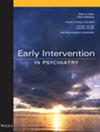Transdiagnostic Symptom Dimensions in Individuals at Ultra-High Risk for Psychosis: Towards Dimensional Representations of Pluripotent Risk
Abstract
Intro
Research has shifted focus from categorical to dimensional conceptualisations of mental health conditions. This is supported by high overlap between disorders, particularly psychosis spectrum and affective disorders, which cuts across traditional diagnostic boundaries. While there is evidence for a general factor of psychopathology in individuals with schizophrenia, schizoaffective disorder, and psychotic bipolar I disorder, transdiagnostic dimensions of psychopathology have not been investigated in young individuals at ultra-high risk for psychosis, that is, youth with pluripotent symptom patterns preceding first-episode psychosis. The current study sought to investigate (1) whether there is a general dimension underlying psychopathological symptoms in individuals and (2) whether the formation of specific symptom dimensions (i.e., positive symptoms, negative symptoms, affect, and activation) is justified alongside a general dimension.
Methods
Item factor analyses were conducted on symptom ratings of the Brief Psychiatric Rating Scale at baseline in the Staged Treatment in Early Psychosis (STEP) trial.
Results
In total, 342 UHR participants were included. A bifactor model with one general symptom dimension and four specific factors (positive symptoms, negative symptoms, affect, and activation) yielded the best relative model fit and interpretability when compared to uni- and multidimensional models, albeit absolute model fit statistics provided no strong evidence to support this finding. However, model stability and interpretability tentatively suggest it can help tell apart pluripotent and domain-specific symptom patterns.
Conclusion
Findings cautiously suggest that the BPRS may index both a general dimension and several more specific dimensions, reflecting pluripotency underlying psychological features in the sample. A ‘common ground’ across the risk syndrome in this heterogeneous sample, with various comorbidities, would lend further evidence to support the notion of a transdiagnostic phenotype in youth.

 求助内容:
求助内容: 应助结果提醒方式:
应助结果提醒方式:


